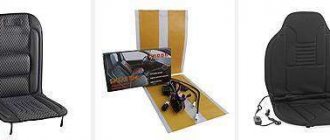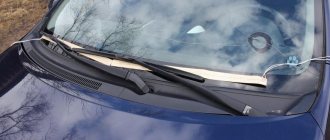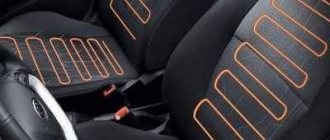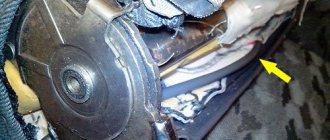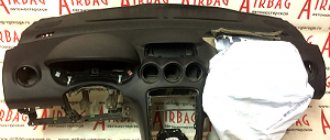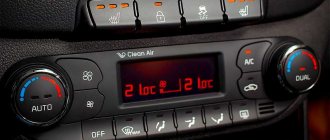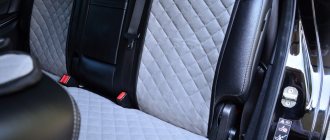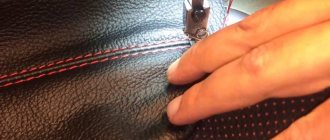Welcome to the kuzov.info blog!
In this article we will figure out how to make heated seats in a car. Let's look at what kits there are for installing heated seats, their advantages and disadvantages. This will help you decide which kit is best to choose for your car. The principle of operation of heated seats, the process of installing and connecting heating elements, and advice on proper operation are given here.
Heated seats are a good addition to a car, increasing comfort, and are installed on expensive cars or on any model as an additional option. If the vehicle is not equipped with heated seats, a kit for installing heated seats can be purchased separately. This can be either a soft substrate with heating elements inside, which is installed on top of the seat upholstery and connected to the cigarette lighter, or a kit for installation under the seat upholstery. In this article we will look at how to make heated seats using a kit that is installed under any seat upholstery (artificial, natural leather or textile). These are very thin heating elements, about 1.5 mm thick, which are not felt at all until they are turned on.
The content of the article:
- What types of heated seats are there?
- How does heated seats work?
- Preparing to install heated seats
- Removing seats and upholstery
- Installation of heating elements
- Connecting the heated seat wiring
- Assembly, installation and testing of heated seats
This article is of a general nature and will be useful as instructions for installing heated seats on any car. In the description of the installation kit you can read that it is intended for professional installation by an experienced specialist. However, the installation process is also accessible to a simple car enthusiast. It is important to carefully study the information provided in this article and do everything consistently and carefully. This can take several hours or two weekends, depending on the skills and efficiency of the installer.
What types of heated seats are there?
There are 2 types of seat heating kits: with a copper heating element and with a carbon fiber heating element (carbon fiber/carbon thread).
Seat heating kits are available in 12V and 24V versions.
Seat heating kit with copper wire heating element
A seat heater with a copper heating element is one long zigzag wire where one end has a positive polarity and the other end has a negative polarity, similar to the filament in a light bulb, which also gets hot.
Heated seats with a copper heating element have the following advantages:
- The copper heating element heats up quickly.
- Heated seats with a copper wire heating element reach a higher temperature than carbon fiber ones.
Disadvantages of heating with a copper heating element:
- The disadvantage is that the rapid heating and cooling cycles will thin the wire and eventually it will burn out.
- Since the copper wire heating element cannot be cut to fit any seat, there are no universal kits that will fit all vehicles. Various sets with a copper heating element are sold for specific car models, or for specific seat sizes. If you are going to install a seat warmer kit with a wire heating element, it must be designed specifically for your car model (to fit), or be smaller than the car seats.
Seat heating kit with carbon fiber heating element (carbon fiber/carbon thread)
The carbon fiber (carbon fiber) heating element has a honeycomb structure. Electrodes (positive and negative) are located at the edges of the heating pad, cells made of carbon fiber are located between these electrodes.
Sets with a carbon heating element have many advantages:
- The heating element of such heating is a carbon (carbon fiber) thread, which is much stronger than copper wire.
- The honeycomb structure makes the heating substrate very reliable. Damage to a single cell does not disable the functionality of the entire heating system.
- Heating elements in the form of carbon fiber can be trimmed with scissors to reduce the size and fit it to a specific seat. This makes the seat heating kit with carbon heating element universal.
Disadvantages of sets with a carbon heating element:
- Carbon filament takes longer to heat up (about 1-2 minutes longer than a copper wire heating element).
- The carbon heating element heats up to a lower temperature (about 5 degrees lower than the copper heating element).
- Heating with carbon wire reaches the highest temperature of 50-57 degrees and the lowest 43-51 degrees Celsius, which is slightly lower than the copper wire element.
As can be seen from the listed advantages and disadvantages, heated seats with a carbon heating element are more preferable, as they are a universal and reliable option. In addition to universal kits, you can also find a seat heating kit specifically for your car on sale. It will fully match the seat configuration of your car, and will have detailed instructions for connecting to your vehicle. The universal kit may need to be adjusted to the location by trimming the lining with heating elements.
Using heating blankets
The simplest way to quickly organize heating of the front seats is to buy a special cover with built-in elements. The product is sewn from thick fabric and equipped with elastic stretchers with metal hooks at the ends. The latter are needed to attach the pad to the seat.
The advantages of the car accessory are obvious - ease of installation and connection (the heating circuit operates from the cigarette lighter socket), the possibility of quick installation using stretchers hooked to springs. But capes have much more disadvantages:
- frankly unpresentable appearance;
- to charge your phone or connect another gadget to power, the heater plug will have to be removed from the cigarette lighter socket;
- only one of the two chairs is heated;
- heated rear seats are not available.
Overlays also have less significant disadvantages that cause inconvenience. The accessory, held in place by elastic bands, fidgets across the chair cushion and constantly works at full capacity. Instances with temperature control have a higher price and often fail.
The option with car covers, where heating elements are sewn, is more convenient and reliable, but expensive. The material of the products is genuine leather, various fabrics and so-called eco-leather. The covers are designed to heat the front and rear seats, are equipped with thermostats and are connected to the on-board network separately from the cigarette lighter.
In addition to considerable cost, heaters in the form of covers have a second drawback - the complexity of installation. It is better to entrust the tensioning of products and electrical connection to specialists from a specialized car service center.
How does heated seats work?
- The technology used to operate heated seats is not too complicated. Heated seats work by placing heating elements under the car seat upholstery. Electricity is passed through the heating element. A heating element can be thought of as a resistor because electricity flowing through it receives resistance and produces heat.
- Like many systems in a car, heated seats are activated using a relay switch. A relay switch is a relatively simple mechanical trigger that allows a device to begin receiving power. A relay allows electricity to switch circuits from less power to more power.
- A thermostat is included in the heated seats as a precaution against overheating. If there is no thermostat, then after starting the heating element will continue to heat up indefinitely. This will cause overheating, which may cause fire, injury or damage to the vehicle. As a safety precaution, the thermostat serves as a heat limiter. Once the heating reaches the temperature set on the thermostat, power to the relay is turned off until the seats have cooled to a certain temperature. The thermostat controls both overheating and underheating. The control unit in the form of a mode switch controls the thermostat settings.
Heating control
The heater is connected to the computer unit of the machine. You can choose operating modes, heat up as quickly as possible, or with average temperature. The driver can set the temperature, when heated to which, the heating turns off automatically. Some modifications of such heaters have a timer function that will turn the device on and off according to specified parameters.
Built-in heaters have the option of accelerating heating, and then switching to standby mode. If you need such heating, then you need to take it with two heating elements.
Depending on the models of car seat heaters, there are different operating modes, some even have up to 8 modes.
Included in the package
- Pads with heating elements for the two front seats (lower and back), wiring and switches.
- Wiring includes thermostatic regulator, fuse holder with 12v fuse, and relay.
- Zip ties and adhesive tape.
- The kit usually contains everything needed for a standard installation of a heated seat kit. If you need any electrical elements (connectors, corrugation, etc.), you can purchase them in addition.
What tools will you need:
- Phillips and flathead screwdriver
- Ratchet wrench with head for removing seats
- Stripping pliers
- Crimper
- Nippers or metal scissors (for cutting the rings holding the upholstery).
- Bladed knife or scissors
- step drill
- soldering iron with solder and solder paste
- marker
- scissors
- multimeter, 12V electrical tester with light bulb.
The photo shows a universal set of seat heating with carbon heating elements in the form of a cellular structure.
Such sets are sold both on Aliexpress and in other online and off-line stores. Additional accessories and installation kits are not required for most installations, but are used by professional installers.
Popular
Since the relay is open, turning the ignition on again leaves the heating off and you must press the button again to turn it on. I didn’t take photographs of this process - everything is done locally anyway.
When they are inserted, a toothed metal plate is clamped on top with pliers and cuts through the insulation.
How to install heated seats in a car yourself? By the way, don’t be lazy and install other heating units.
Now you can put the rear trim element on the hooks. In this case, the on-board network will not be affected if the heating fails. Experts recommend choosing the standard ones provided for the VAZ. The connection of control, indication and button illumination was carried out with a two-core wire.
Simple universal heated seats and a diagram of connecting it to the car
I plopped down on the icy seat for a couple of seconds, started the car, pressed the heating button, and within a couple of minutes the seat was already warm. Element Explanation Heating elements These are required for the backrests and seats.
Do you use heated seats? This arrangement of switches will be the most successful from the point of view of ergonomics and comfort. The best opportunity for self-installation of heating elements remains in cars that already have a system installed, but not installed by the manufacturer.
With a correctly assembled circuit, the heating will function only when the ignition is on. Didn't find the information you are looking for?
Preparing to install heated seats
First, disconnect the battery and let the car sit for 10-20 minutes to allow the SRS to fully discharge. Once the airbag (SRS) related connectors have been disconnected, the battery must not be reconnected until you turn on all SRS components again, otherwise an error will occur.
On vehicles with seats that have side airbags, you must follow a certain procedure before removing the seats to avoid an error (may not work on all vehicles):
- Turn off the car and leave the key in the ignition off.
- Disconnect the negative terminal of the battery and insulate it with a rag or plastic bag so that it does not accidentally reconnect. You must wait at least 5 minutes before proceeding to the next step.
- Remove the seats, disconnect the airbags, seat belts, power connectors for the power seats. Do not turn on the ignition while the seat is removed and all connectors are disconnected.
- When the seat is installed and screwed into place and all connectors are connected (the ignition key must be in the off position), connect the negative cable to the battery.
If the seats have side airbags, then before removing the seats you need to disconnect the negative terminal of the battery to avoid an error.
So, let's first look at the brief installation instructions, and then we will analyze each point in detail.
How to assemble heated car seats yourself?
First of all, check whether you have the necessary basic set of tools and materials:
Of course, this list may vary depending on the specific kit you purchased. For example, if it does not have wiring or a safety connector, you will have to purchase them separately. For wiring, 2.5 mm stranded wire is used.
Before you begin installing the heated front seat, pay attention to the configuration of the control buttons in your kit. It is necessary to consider the method of their fastening, the size, so as not to make a mistake with the installation of this block. Otherwise, you will be forced to mount it in another place or fork out for a branded kit for your car brand. Further installation of seat heating with your own hands is carried out in the following typical order:
Experienced car owners advise that when placing the wiring from the regulators to the heating elements, do not leave them taut; a reserve is needed for the retractable seat.
Installation instructions:
Disconnect the negative battery terminal.
- Remove the seats from the interior.
- Remove the upholstery.
- Place a pad with heating elements on the back and seat.
- Identify a power resource that is capable of delivering a continuous 10 amps of current. Once you have determined the power resource, wire to that resource.
- Find a suitable location for the switch. Drill a hole in the desired location and pull a connector through the hole, then connect it to the switch and attach it.
- Place the seats in place in the interior and fasten them. Connect all connectors under the seat, along with the new heater connector.
- Connect the battery and turn on the ignition.
- Check heating in all modes.
Equipment and installation features
Installation of the Emelya management system is considered one of the simplest in terms of installation work. The kit for installing heated seats includes heaters, a control button, mounting wires, and instructions. It has four operating modes, the model is protected from overheating, and is equipped with a timer that turns off the device after 30 minutes.
Each chair is equipped with two heating elements - on the back and the bottom. For heating, reinforced wire developed by is used. It has phenomenal flexibility and tensile strength, significantly superior in strength to analogues made from copper and nichrome wire.
The design of the heating elements is thought out to the smallest detail. The wires are laid in such a way that damage is excluded even with knee pressure. The fibers are connected in parallel: if one of the threads fails, the rest will continue to work. A protective layer located under the heating elements prevents heat from escaping downwards. Heating mats are moisture-resistant: the chairs are not susceptible to dry cleaning or water accidentally spilled on the upholstery.
Removing the seats
Disconnect the battery terminal before disconnecting the seat. Otherwise, the airbag error will light up (if the seat has one). Disconnect power from the seat last.
The seat is attached to the car floor with 4 14 mm bolts. The rear bolts are covered with plastic covering.
The plastic needs to be removed and the bolts unscrewed.
To make it easier to remove the seats, remove the headrests, seat belts and anything else that prevents the removal of the seats.
The removed seat is easy enough to stick out of the cabin. Start pulling it out from the back. Be careful as the metal runners have sharp edges that can damage the plastic. It is better to place the seat on some kind of elevation (a bench or table) to make it more convenient to work with it. Lay or place something under the seat as the metal runners can damage the surface. Remove all side plastic covers.
We make our own heated rear seats
Installation of heated rear seats is not often found in cars, even in the maximum configuration. And although most drivers are not that interested in it, many drivers with large families are very interested in it. The procedure for installing and connecting the heating generally coincides with that indicated above.
In order to install built-in heated rear seats on your own, you will need 2 sets of heating units.
As a “ground”, a number of experienced motorists advise connecting to the seat belt fastening - this gives quite reliable contact. Everyone is free to position the control buttons at their own discretion. Alternatively, this is often the back of the armrests of the front car seats or the inner panel of the door trim. This allows passengers to comfortably adjust the heating.
Removing the seat upholstery
To install a seat heater, you need to gain access under the seat upholstery and backrest. To begin removing the upholstery from the seat, you need to remove all the metal rings (hog rings) that hold the upholstery. Start at the bottom back of the seat. Turn the seat over for better access and start cutting off the rings with wire cutters.
The instruction manual, which can be purchased or downloaded on the Internet, may be useful during disassembly. The service instructions may contain information about disassembling the seat (removing the upholstery), the location of all fasteners.
When disassembling the seat, take a photo before you remove anything, so that later, when reassembling, you can look at the photo as a hint.
Once the edges of the upholstery are free, lift up the edge of the upholstery to gain access under the upholstery and begin cutting away the fasteners (rings) that secure the center section of the upholstery. Instead of fastening rings, you can use small ties. Clean the surface of the soft part of the seat, as the heating will stick to the seat.
The seat back may have 2 brackets for attaching the headrest. There is no need to remove them, as they will not interfere with the heating installation. They may also break when removed.
How to connect seat heating
Not all modern cars are equipped with heated seats, because such an option is usually included in more expensive equipment options. Despite the fact that the arguments for and against such an upgrade are quite numerous, most car owners still install such an improvement on their car on their own. So, let's talk about how to make heated seats yourself.
Types of heating for self-installation
These types of devices for different car brands are very diverse these days and can satisfy the most demanding requests.
First of all, we should highlight two fundamentally different approaches to heating: Built-in heating elements
Heated seat covers and capes
Before you start installing a car seat heater yourself, you need to take into account that the first option is much more budget-friendly and less technically complex. In this case, you just need to put the cover on the seat and backrest, connect it to the on-board network - and you are guaranteed warmth. Most often, the heater is connected to a car cigarette lighter, but sometimes terminals are also used. With all this, the use of a heating cover also has significant disadvantages:
There is one more inconvenience. Most people use the cigarette lighter to connect other devices (in particular, navigators, video cameras, chargers for smartphones). And just in this case, a splitter is not the best solution, since the heater requires significant energy, so there is a possibility of tripping the fuses. In addition, the fire safety of the vehicle is reduced. The connection diagram for heated seats requires a thoughtful approach.
Options with built-in heating
Car owners who are interested in connecting heated seats in Moscow and other cities, as well as those who want to install heated car seats on their own, often find this method difficult in advance, since it requires installation skills. But the connection diagram for seat heating is not so complicated in practice, especially if you carefully follow the instructions of experts. Anyone who can hold a screwdriver in their hands can adjust the operation of the built-in heating. You just need to carefully study the instructions and have the necessary set of tools. In addition, built-in devices have undeniable advantages:
Installation of heating elements
- The installation process for the driver and passenger seats is the same, with the exception of one feature, which we will discuss below.
- After installing the heated seats, the only visible thing should be the heating mode switch.
- The heated pad is placed between the seat upholstery and the seat cushion.
- For the longevity and reliability of the heating elements, it is important that they are positioned correctly. Heating elements can only be placed in the middle of the seat. They should not go into the lateral support. Heating elements must be installed without folds.
- The pads can be trimmed slightly in length (the edge opposite the edge with the wiring) so that they fit well in place. Seal the edge using the adhesive tape included in the kit. You cannot cut the heated pad too wide. You can see how the long wire along the edges shows through - it cannot be cut. It is allowed to trim the edges a little to this wire. This may need to be done so that the heating elements do not come into contact with the side seams.
- Place the heating element intended for the seat and align it on the soft part of the seat. Use a marker to mark the location of the upholstery attachment points (rings or others). Using scissors, cut holes in the heating pad for these fasteners. Cut several strips of tape and cover the exposed ends of the heating elements around the hole.
The pad with heating elements has a double-sided adhesive tape for fastening under the upholstery, on the soft part of the seat.
- If the seat has recessed channels, then the heating element cannot be pushed into them. You need to cut out a heating lining for them in the places where the heating elements are located, having previously marked these places with a marker. After this, the exposed edges of the heating element must be insulated by gluing the tape from the kit.
- Never cut holes in an area covered with tape. Areas with adhesive tape should only be applied to a flat seat surface.
- The heating element should not touch any conductive surfaces (metal rings - upholstery fasteners, seat frame) to avoid a short circuit.
- The old, classic fastenings are metal rings, while the new, more modern ones are Velcro fastenings. For older fasteners, apply the included tape around the rod to insulate it. Velcro fastenings can be sewn onto the lining with heating elements. Thus, there is no need to cut heating elements for this type of mount.
- The soft seat backing must be clean before installing the heating.
- Peel off the protective layer from the back of the adhesive part of the heated pad and carefully apply it to the seat in the desired position. The strength of the heated adhesive joint is achieved by applying sufficient pressure. The heating element cannot be separated and rearranged after gluing.
Universal heating elements must be cut out at the places where the upholstery is attached. Exposed edges must be sealed with adhesive tape included in the installation kit.
- The passenger seat may have a sensor that responds to the passenger's weight to activate or disable the passenger-side airbags in the event of an accident (Occupant Detection System). After removing the seat upholstery, you need to determine whether there are sensors located on top of the seat. Toyota, Kia and Hyundai usually place the sensors on the surface of the seats (bottom). Honda usually places the sensors on the back of the seat. Heating cannot be installed on top of this sensor. In this case, you can install heating only on the part of the seat where there is no sensor (the back or vice versa, only the seat). Also made at the factory. When you buy a Toyota car with such a sensor, from the factory it only has heated backrests of the passenger seat. When you purchase a Honda, from the factory it only has heated seats, and the backrest is not heated (since the sensor is located on the backrest).
- It may be necessary to cut a channel for the temperature controller and wire with a knife in the soft part of the seat so that it is not noticeable after installing and assembling the seat.
Installation of factory elements
For almost any car you can purchase a heating installation kit, which includes the following parts:
- heating elements for seats and backrests;
- connecting wires with connectors;
- power buttons;
- Temperature regulator.
There are 2 types of kits: original, designed for a specific car model, and universal. The latter are selected according to the size of the pillows.
To install such seat heating yourself, it is recommended to completely remove the seats from the car. Then follow these instructions:
- For convenience, disassemble the sofa into 2 parts, separating the back.
- Carefully remove the outer trim (the method of fastening depends on the make of the car).
- Place the heating elements on top of the foam inserts and secure by gluing or in another way provided for in the kit instructions.
- Stretch and secure the upholstery, assemble the chair and place it back into the cabin. Lead the wires down and lay them under the floor covering to the point where the buttons are mounted.
- Insert the button blocks into the free space of the center console. Connect the heaters to the on-board network by installing an additional fuse.
It’s easier to install the original set of products yourself - the buttons are made to fit standard sockets with plugs, and the heating inserts fit perfectly to the size of the seats. You will have to tinker with the parts of the universal set - the button blocks need to be embedded into the plastic panel, choosing a convenient place. The protruding edges of the heaters are tucked under the side support elements.
Note. In some cars, it is not necessary to remove the upholstery of the sofas. The design allows you to insert the heater under the cladding from the rear side.
The many advantages of such kits are overshadowed by one drawback - the not very affordable price of quality products. Cheap Chinese copies that fit the sofas of various cars quickly fail, as evidenced by numerous reviews from car enthusiasts.
Connecting the heated seat wiring
- It will be more convenient to conduct wiring from the seats to the power source when the seats are removed and located outside the cabin.
- The wiring must have a reserve length and be stretched so that you can change the position of the seat without any difficulties. The cable should not touch sharp edges, bend or be strained to avoid damage.
- Think about where you can hide the heating wiring. The most suitable places are under the center console, which is located between the front seats, under the carpet, at the edge of the footrest, or in the place where the threshold is located.
- Study the heating connection diagram, which is in the instructions, as well as the wiring diagram of your car. You need power for the heated seats that will turn off completely when the ignition key is removed.
Simplified connection diagram for seat heating
- The positive (usually red wire) can be connected to the positive ignition power supply.
- Securely connect the ground (black wire) with a small terminal to the body negative (ground). Improper grounding may cause the heating to not work.
- Select a suitable location for mounting the switch that is easily accessible to the driver and passenger, and ensure that there is enough space behind the switch for the wiring and switch bracket. This could be on the side of the seat, on the front of the dashboard, or on the panel that runs between the driver and passenger seats. Mark the location and drill approximately a 20mm hole to install the switch. The hole should not be too small or too large. This is important for securely attaching the switch. The most suitable place for the switch is on the plastic trim located on the side of the seat.
Select a location that is easily accessible to the driver and passenger to install the switch.
conclusions
How to decide on the brand and parameters? You just need to sit down and think about what you need - heating power, heating locations, overhead or built-in, and so on. But it is advisable to adhere to the following tips:
- The heater must have automatic support for the optimal temperature.
- The heating should turn off after a certain time.
- It is desirable that the power level be adjusted, and there should be an indication of mode selection.
- Heating should be uniform and not concentrated at one point.
- The set should be easy and simple to install, while the heater mounts should be durable and comfortable.
- Heated seats must have overheating protection and an emergency shutdown.
Many sources say that you should not constantly use the heater, especially in severe frost. This is due to the fact that sudden strong cooling of the lower part of the body, and then sudden heating, is the path to radiculitis and other diseases. It is because of this that it is better to have a heater with power control.
Assembly and installation of seats
To install the upholstery on the lower part of the seat, you can use vinyl ties instead of cut rings. Insert the zip ties into the places where there were rings holding the upholstery, but do not tighten them yet. Pull the zip ties through the holes. Starting at the back, connect the zip ties and tighten them a little so they don't come apart again. Once all the zip ties are connected, tighten them and cut off the remainder. To install the upholstery on the backrest, turn the upholstery inside out and begin to gradually tighten it, unrolling it down onto the backrest. Disassembling and assembling a car seat is also described in the article “do-it-yourself seat reupholstery.”
After assembly, the seats are installed back into the cabin, all connectors are connected, including the new one going to the heated seats. Next, you can connect the negative terminal of the battery, turn on the ignition and test the heated seats.
Built-in heating systems
Such systems are mounted between the upholstery of car seats and the foam filling. Covers and covers used to heat seats are less durable and convenient to use than built-in heating systems.
Structurally, they consist of multilayer mats with built-in nichrome spirals, or heat and carbon fiber heating elements.
Features of built-in heating:
- Models with nichrome spirals are cheaper than others, but in some cases their installation is difficult;
- Systems with heat and carbon fiber heating elements can be easily mounted on any seat, are easy to cut and bend, but their prices are higher than for other systems.
Advantages of built-in heating::
- Such systems are connected not to the cigarette lighter, but to a special power source that can be installed anywhere;
- Hidden electrical wiring;
- The design provides for heating of all seats, both front and rear;
- Reliability;
- The presence of a thermal relay ensures safe operation.
Which built-in heating to buy
WAECO heated seats are considered the best, but cost accordingly
The best built-in heating is from the WAECO brand; German quality does not require recommendations, but it is not cheap.
Kits from China and Taiwan are attractively priced, heat efficiently, but break down very quickly. They are not particularly reliable; short circuits often occur, which not only destroy all electrical wiring, but also lead to fires.
The golden mean between price and quality is offered by Russian manufacturers, the most famous of which is, famous for its “Emels”.
